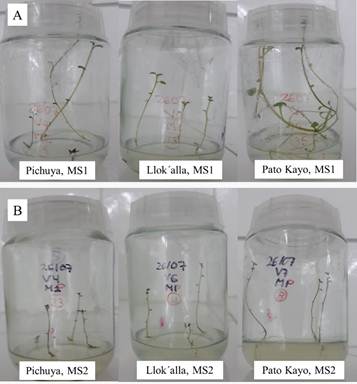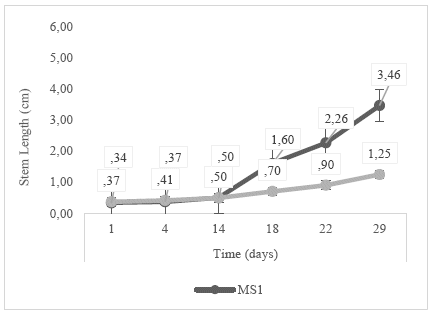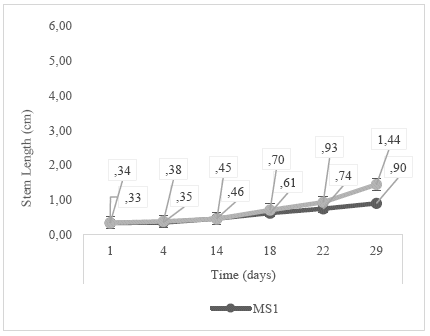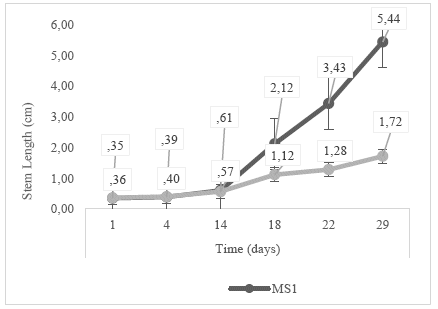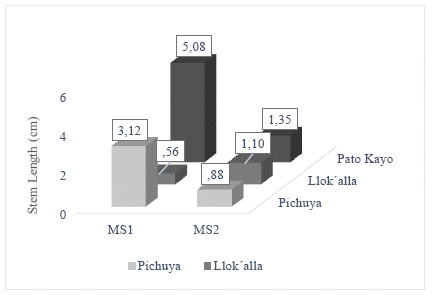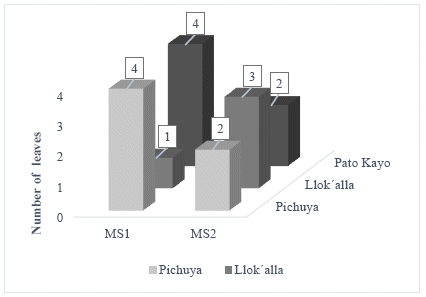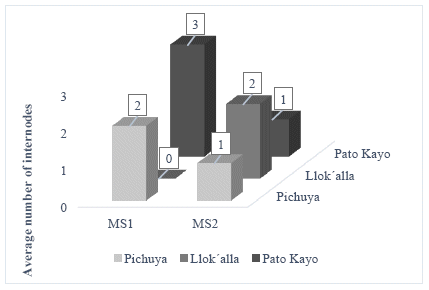Journal of the Selva Andina Biosphere
versión impresa ISSN 2308-3867versión On-line ISSN 2308-3859
J. Selva Andina Biosph. vol.11 no.1 La Paz 2023 Epub 01-Mayo-2023
https://doi.org/10.36610/j.jsab.2023.110100063
INFORMACIÓN TÉCNICA
Evaluation of the multiplication of three native potato (Solanum sp.) varieties for the conservation of native species
1Military School of Engineering. Science and Technology Research Unit. Plant Biotechnology Laboratory. Playón Irpavi: Av. Rafael Pabón s/n. Alto Irpavi Campus. Tel: +591-2793155. La Paz, Plurinational State of Bolivia.
Desafortunadamente, en Bolivia variedades nativas están siendo desplazadas por las comerciales, provocando la reducción o descarte de su producción al no tener un mercado seguro, poniendo en riesgo su conservación. El objetivo de la investigación se centró en evaluar dos medios de cultivo M & S en la fase multiplicación de tres variedades de papa nativa (Solanum sp.) de la comunidad Millimbaya, municipio Tacacoma, para la conservación de especies nativas. Por lo cual, se ha muestreado tres variedades de papa nativa de Tacacoma: Pichuya, Llok´alla y Pato Kayo, las cuales, tras un proceso de selección de explantes y desinfección de brotes fueron establecidas in vitro a 21±1° C, flujo luminoso de 2000 lm y fotoperiodo 16:8 h, por 25 días. En la fase multiplicación, se empleó el diseño experimental factorial asimétrico para el estudio de los factores: variedad y medio de cultivo, donde las variables respuestas evaluadas fueron: altura del tallo, número de hojas y entrenudos. Los resultados de la investigación mostraron la preferencia de las variedades Pichuya y Llok’alla al medio MS1(MSP01) compuesto de 332.2 mg/L CaCl2, 180.7 mg/L MgSO4 y 16.9 mg/L MnSO4, al presentar mayores promedios en longitud, número de hojas y entrenudos que al ser cultivados en medio MS2, y la respuesta favorable de la variedad Llok´alla al medio MS2.
Palabras clave: Erosión genética; multiplicación; medio de cultivo; Murashige and Skoog; variedades nativas; in vitro; conservación
Unfortunately, in Bolivia native varieties are being displaced by commercial ones, causing the reduction or discarding of their production because they do not have a secure market, putting their conservation at risk. The objective of this research is to evaluate two M & S culture media in the multiplication phase of three native potato varieties (Solanum sp.) from the Millimbaya community, Tacacoma municipality, for the conservation of native species. Therefore, three native potato varieties from Tacacoma were sampled: Pichuya, Llok´alla y Pato Kayo, which, after a process of selection of explants and disinfection of shoots, were established in vitro at 21±1° C, 2000 lm light flux and photoperiod 16:8 h, for 25 days. In the multiplication phase, the asymmetric factorial experimental design was used for the study of the factors: variety and culture medium, where the evaluated response variables were: stem height, number of leaves and internodes. The results of the research showed the preference of the varieties Pichuya and Llok´alla to the MS1(MSP01) medium composed of 332.2 mg/L CaCl2, 180.7 mg/L MgSO4 and 16.9 mg/L MnSO4, when presenting greater averages in length, number of leaves and internodes than when cultivated in MS2 medium, and the favorable response of the Llok'alla variety to MS2 medium.
Keywords: Genetic erosion; multiplication; culture medium; Murashige and Skoog; native varieties; in vitro; conservation
Introduction
The potato crop in Bolivia is considered the basis of the food diet of the Bolivian population and economic livelihood of families living in rural areas. In 2017, it was constituted as the ancestral crop with the largest area, occupying, an extension of 182675.0 ha with production of 1 174743.7 qq1.
Bolivia has a wide variety of potatoes, due to the differences in altitude, climate, soil and physiography of the regions that produce them. There are 18 varieties that are commercially cultivated2, out of a total of 1555 known varieties3.
Ramos Yucra4 mentions that, of all the varieties, Huaycha (Solanum tuberosum sp.) is the most cultivated, due to an assured market in the main cities of Bolivia, however, non-commercial native varieties are cultivated for the self-consumption of producer families in reduced areas, due to the lack of market opportunities. This scheme is causing more producing families to reduce or discard the production of native varieties, if the local ancestral knowledge of conservation techniques is progressively lost, the availability and quantity of native seeds is reduced, causing the gradual loss of native potato varieties (genetic erosion).
The application of biotechnological tools, such as in vitro culture, will make it possible to obtain pathogen-free explants, ensure good development by growing in a culture medium with the necessary nutritional elements, increase the yield of the variety and is an alternative for the mass propagation of seedlings, as it requires short periods of time and reduced space, making it a potential technique for the ex situ recovery of native potato varieties5.
Aliaga García6 mentions that the success obtained in vegetable crops will depend on the use of the adequate medium with the necessary chemical substances and appropriate combinations of its components.
Therefore, the objective of this research was to evaluate 2 M & S culture media in the multiplication phase of 3 native potato varieties (Solanum sp.) from the Millimbaya community, Tacacoma municipality, for the conservation of native species.
Materials and methods
The study was carried out in the facilities of the Plant Biotechnology Laboratory of the Science and Technology Research Unit (UICYT) of the Military School of Engineering (EMI) Academic Unit La Paz-Bolivia, Alto Irpavi University Campus, located at coordinates (UTM) 598000.00 m E and 8171886.00 m S, 19S.
Sampling of native potato varieties. The plant material of the 3 varieties of native potato (Solanum sp.) Pichuya, Llok'alla and Pato Kayo, was obtained from a productive plot belonging to the Millimbaya community, Municipality of Tacacoma, at coordinates (UTM) 538830.877 mE and 8273262.153 mS, 19S.
For sampling, the protocol recommended in the plant tissue manual7 was adopted, its choice is based on the fact that days prior to sampling the crops were affected by frost during their development in the field, so it was considered important to sample complete seedlings in order to recover the undamaged meristems in the laboratory.
The procedure consisted in the sampling of complete seedlings with soil from the site, subsequently, they were introduced in sampling bags duly labeled, to finally be stored in a container to avoid any mechanical damage during their transfer to the laboratory.
Phase 0: Selection and disinfection of plant material. After sampling, the plant material was taken to the laboratory 24 h later, to continue with the selection based on the characteristics of the explants, choosing those with good sanitary condition, to reduce the risk of contamination by fungi and bacteria during the establishment of the in vitro culture8.
The explants were washed with a drop of detergent and water, followed by disinfection in 70% (v/v) alcohol for 1 min, then immersed in a 3% (v/v) sodium hypochlorite solution for 10 min, and finally rinsed 3 times in distilled water inside the laminar flow chamber9.
Phase 1: Establishment. The disinfected segments of the 3 strains were cultured inside the laminar flow chamber in 14 test tubes of 10 cm with culture medium with M&S culture medium, 500 mL of which was prepared using 2.165 g of Murashige and Skoog Basal Salts MSP01, 3 % (w/v) sucrose, 0.05 g of Myo-inositol10, 15 mL of calcium pantothenate and 2 mL of vitamins. The initial pH 4.4 was adjusted to 5.7 with 0.1 N NaOH11 and autoclaved at 121° C, with prior addition of 2.15 g of agar.
The cultured explants were taken to the plant growth chamber exposed to an average temperature of 21±1° C and artificial light provided by a 20 W LED bulb with a luminous flux of 2000 lm, with a 16:8 h photoperiod (light/dark), for 25 days.
The parameters evaluated were: stem length (SL), number of leaves (NL), absence or existence of microbial contamination (C), in order to analyze the growth of each variety and its adaptation to the environment.
Phase 2: Multiplication. After 25 days of cultivation of established segments, those axenic cultures that were able to adapt, with physiologically vigorous characteristics, were selected for repotting from transverse cuts of the stem with axillary bud of 0. 4 cm, sown in MS110 culture medium in a laminar flow chamber and exposed to the same environmental conditions of 21±1° C, luminous flux of 2000 lm, and photoperiod 16:8 h for 30 days, to obtain prenuclear material in view of the reduced number of vitroplants adapted to the medium in the establishment phase.
Having obtained a greater number of prenuclear plant material, the next step was to identify the optimum culture medium to obtain a higher yield in growth of 3 varieties. The "asymmetric factorial" experimental design was used, consisting of 2 factors, variety (A) and culture medium (B), the former consisting of 3 levels (A1= Pichuya, A2= Llok'alla and A3= Pato Kayo) and 2 levels (B1= MS1 and B2= MS2) (Table 1), considering 11 replicates per treatment and establishing 66 experimental runs.
Once the design was established, 1 L of MS1 and MS212 culture medium was prepared and autoclaved at 15 psi and 121° C13.
Table 1 Treatments evaluated in the meristem multiplication phase of three native potato varieties
| Treatment | Calcium chloride (mg/L) | Magnesium sulphate (mg/L) | Manganese sulphate (mg/L) |
|---|---|---|---|
| MS1 | 332.200 | 180.700 | 16.900 |
| MS2 | 440.200 | 370.700 | 22.300 |
Next, new explants were obtained from successive transverse cuts of nodes from the meristematic seeding14, each segment had an initial length of 0.3 to 0.4 cm, were seeded (inside the laminar flow chamber) in flasks with 30 mL of MS medium according to the established experimental runs. The cultures were exposed for 29 days to the same environmental conditions as in the establishment phase, and the following variables were evaluated: absence or existence of C, LT, NH and number of internodes (NEN).
During 29 days, data were periodically collected for the variables under study, with a total of 6 evaluations, which were recorded in the Minitab 19 Trial software for subsequent statistical analysis and construction of the growth curve by variety.
Results
Development of native potato seedlings, establishment phase. The results of LT, the Pato Kayo variety presented the greatest height with 4.7 cm, compared to Pichuya and Llok'alla which reached 2.2 and 2.6 cm respectively.
Regarding NH per vitroplant, Pato Kayo developed 9 leaves, Llok'alla 8 and Pichuya 5.
In order to establish the percentage of explants per variety that managed to adapt to the culture medium and controlled conditions of light and temperature, from the variable C, the survival was 60 % Pichuya and Llok'alla, 25 % for the variety Pato Kayo.
Figure 4, the percentage of explants contaminated by variety, 25 % of explants of the Pato Kayo variety established were contaminated 20 % in Pichuya and 60 % in Llok'alla.
Some explants of the cultivated varieties, in the 25 days of evaluation, did not increase the LT, and presented yellowish to cinnamon tones in their structure, indicative of the presence of oxidation. The percentages of oxidation were Pato Kayo 50%, Pichuya and Llok'alla 20 and 40 %, respectively.
Evaluation of seedling development, multiplication phase. The data collected from the 66 experimental runs were analyzed for the parameters: LT, NH, NEN.
However, the growth curve of each variety cultivated in vitro was constructed based on the measurement of the variable LT per variety (Figures 2, 3 and 4). The adaptation phase has a duration of 14 days, to initiate the exponential phase, Pato Kayo obtained the most accelerated growth, reaching an average length of 5.44 cm by day 29, compared to Pichuya and Llok'alla with an average length of 3.6 cm and 1.44 cm by day 29, respectively.
For day 29, a percentage of 31.8 % of contaminated explants of the cultivated ones was recorded.
Using Minitab 19 Trial software, the analysis of variance was calculated at 95 % reliability for the 3 response variables of the study, considering for each result: i) If the probability value > at the significance level (p-value) 𝛼 = 0.05, there is no significance. ii) If the probability value < at the significance level 𝛼 = 0.05, there is significance.
From the analysis of variance of LT, Table 2, it is determined that the probability values (p-value) associated with the F statistic, of the factors, are less than the significance level 𝜶 = 0.05, that is, the factors considered significantly affect the final length achieved (Table 2), affirming that, the mean of the factors, are statistically different, which is verified with the Tukey test by not sharing letters (Table 3).
From the analysis of variance of NH (Table 2), it is established that the probability values of the study factors are greater than the significance level 𝛼 = 0.05, i.e., that the factors considered do not significantly affect the response variable, total leaf bud, confirming that the mean of the factors considered are statistically equal, which is verified by the Tukey pairwise comparison (Table 3).
Finally, from the analysis of variance of the NEN (Table 2) it is determined that the values of the probability of the variety factor are less than 𝜶 = 0.05, showing that the study factors have a significant influence on the final number of internodes obtained, that is, that the mean of the factors are statistically different, which is verified with the Tukey test (Table 3).
Table 2 Analysis of variance: LT, NH, NEN
| Stem length | |||||
|---|---|---|---|---|---|
| Fuente | GL | SC Ajust. | MC Ajust. | Valor F | Valor p |
| Culture medium | 1 | 53.28 | 53.28 | 15.68 | .000 |
| Varieties | 2 | 63.97 | 31.984 | 9.42 | .000 |
| Error | 60 | 203.82 | 3.397 | ||
| Total | 65 | 372.5 | |||
| Number of leaves | |||||
| Culture medium | 1 | 6.524 | 6.524 | 2.27 | .137 |
| Varieties | 2 | 18.824 | 9.412 | 3.27 | .045 |
| Error | 60 | 172.466 | 2.874 | ||
| Total | 65 | 259.872 | |||
| Number of internodes | |||||
| Culture medium | 1 | 7.168 | 7.168 | 4.99 | .029 |
| Varieties | 2 | 14.78 | 7.39 | 5.15 | .009 |
| Error | 60 | 86.125 | 1.435 | ||
| Total | 65 | 139.596 | |||
Table 3 Comparisons of Tukey pairs: LT, NH, NEN
| Stem length | |||||
|---|---|---|---|---|---|
| Factor | N | Mean | Group | ||
| Culture medium | MS1 | 33 | 3.264 | A | |
| MS2 | 33 | 1.467 | B | ||
| Varieties | Pato Kayo | 22 | 3.578 | A | |
| Pichuya | 22 | 2.352 | A | B | |
| Llok´alla | 22 | 1.167 | B | ||
| Number of leaves | |||||
| Culture medium | MS1 | 33 | 2.96212 | A | |
| MS2 | 33 | 2.33333 | A | ||
| Varieties | Pato Kayo | 22 | 3.28409 | A | |
| Pichuya | 22 | 2.68182 | A | ||
| Llok´alla | 22 | 1.97727 | A | ||
| Number of internodes | |||||
| Culture medium | MS1 | 33 | 2.00758 | A | |
| MS2 | 33 | 1.34848 | A | ||
| Varieties | Pato Kayo | 22 | 2.26136 | A | |
| Pichuya | 22 | 1.67045 | A | B | |
| Llok´alla | 22 | 1.10227 | B | ||
From the results obtained from the analysis of variance and the comparisons of each factor studied (Tukey test), the levels that reached the highest average in LT, NH and NEN in cultivated vitroplants were determined.
From these results of main effects, it was determined that the Pato Kayo variety, cultivated in MS1 culture medium, was the one that presented the highest average in LT, NH and NEN, becoming the variety best adapted to the MS1 culture medium, in the multiplication phase.
Figure 5 of average length of the vitroplant indicates the positive effect of MS1 medium on Pichuya and Pato Kayo varieties, reaching heights of 3.12 and 5.08 cm respectively, unlike the Llok'alla variety that reached a greater average length when grown in MS2 medium.
Regarding the NH of cultivars grown in MS1 and MS2 media, Figure 6 shows that the Pichuya and Pato Kayo varieties grown in MS1 medium developed a higher NH (4) than those grown in MS2 medium. On the other hand, the Llok'alla variety developed a higher NH when grown on MS2 medium (3).
Regarding NEN, Figure 7, favorable results were achieved in crops of the Pichuya and Pato Kayo varieties planted in MS1 medium, with an average of 2 and 3 internodes respectively, in contrast to those grown in MS2 medium; however, for the Llok'alla variety, MS2 medium was the optimum medium to develop higher NEN (2).
Discussion
The analysis of the parameters evaluated in the establishment phase allowed obtaining preliminary results of the behavior of the 3 native potato varieties with respect to their adaptation to controlled laboratory conditions, revealing that despite the fact that the mother plants for obtaining meristems have previously suffered frost stress conditions during their development in the field, and despite having a reduced number of explants with a sanitary condition, it has been possible to recover vigorous vitroplants that have survived their establishment in the laboratory.
As has been observed, in the establishment phase, variable results were obtained in the percentage of survival, contamination and presence of rust depending on the variety cultivated. The varieties that responded favorably to the protocol adopted for disinfection and cultivation conditions in their establishment were: Pichuya and Llok'alla, obtaining 60% of surviving explants, presenting a percentage of contamination of 20% and 0%, and oxidation of 20% and 40%, respectively. In comparison with the Pato Kayo variety, which achieved a survival rate of 25 %, contamination of 25 % and oxidation of 50 %.
Perea Dallos et al.15 mentioned that it is important that not all explants require the same disinfection process, since it could vary according to the morphology and environmental conditions to which they were exposed. Therefore, probably, being field-sampled varieties, Pato Kayo could have been exposed to more pathogens, which would require a different disinfection protocol.
As for the percentage of oxidation, it could be due to the concentration of NaClO used, since it was not ideal according to the characteristics of the explant of each variety, or that the rinsing was not sufficient to eliminate the remains of hypochlorite16.
On the other hand, no similar research has been described in the scientific literature that evaluates the use of a MS16 culture medium in the in vitro cultivation of native potato varieties, or precedents that evaluate the adaptation and growth of the Pichuya, Llok'alla and Pato Kayo varieties to the basic MS medium, through this study it was possible to know their response.
Regarding the results obtained in the multiplication phase, it has been possible to construct the growth curve for each variety evaluated, revealing that in all cases, the adaptation phase lasted 14 days; however, in the exponential phase, variations in the response were observed, Pichuya and Pato Kayo presented a positive response to MS1 medium in comparison to the results obtained when cultivated on MS2 medium, with Pato Kayo being the variety that presented the greatest exponential growth. On the other hand, the Llok'alla variety showed a higher exponential growth when grown on MS2 medium.
The analysis of variance, carried out with Minitab 19 software, allowed observing the significance of the factors considered in the study (culture medium and variety), which had a significant influence on LT and NEN with a p-value of less than 0.05. Likewise, the analysis of main effects showed that the Pato Kayo variety cultivated in MS1 medium presented the best response in LT, NH and NEN, being in turn the best adapted to MS1 medium.
Likewise, the Pichuya variety achieved higher LT, NH and NEN when grown on MS1 medium, compared to the Llok'alla variety with a favorable response to MS2 medium.
The results according to each variety could be influenced by the variation of CaCl2, MgSO4 and MnSO4 concentration in the MS1 and MS2 media (Table 1), the preference of the Pichuya and Pato Kayo varieties to the MS1 medium composed of 332. 2 mg/L CaCl2, 180.7 mg/L MgSO4 and 16.9 mg/L MnSO4, and of Llok'alla to MS2 medium with 440.2 mg CaCl2, 370.7 mg/L MgSO4 and 22.3 mg/L MnSO4. Finally, the culture medium indicated for the massive in vitro propagation of native varieties Pichuya and Pato Kayo would be the MS1 and MS2 medium for Llok'alla, constituting an alternative for their conservation.
REFERENCES
1. Cultivos ancestrales superan las 200 mil hectáreas cultivadas [Internet]. Instituto Nacional de Estadística. 2018 [citado 5 de septiembre de 2021]. Recuperado a partir de: https://www.ine.gob.bo/index.php/cultivos-ancestrales-superan-las-200-mil-hectareas-cultivadas/ [ Links ]
2. Iriarte V, Condori B, Parapo D, Acuña D, Rojas W, Patsu Y, et al. Catalogo Etnobotánico de papas nativas del Altiplano Norte de La Paz-Bolivia [Internet]. La Paz: Ministerio de Relaciones Exteriores y Culto; 2009 [citado 20 de octubre de 2021]. 146 p. Recuperado a partir de: https://www.bivica.org/files/papas-nativas-catalogo.pdf [ Links ]
3. Sembrando 1.555 variedades de papa para su conservación genética [Internet]. Cochabamba: Instituto Nacional de Innovación Agropecuaria y Forestal; 2011 [citado 22 de octubre de 2021]. 2 p. Recuperado a partir de: https://www.bivica.org/files/sembrando-papa.pdf [ Links ]
4. Ramos Yucra BC. Identificación de variedades perdidas de papa (Solanum sp.) y los factores que incidieron en su desaparición en tres comunidades del municipio de Batallas [tesis licenciatura]. [La Paz]: Universidad Mayor de San Andrés; 2016 [citado 26 de octubre de 2021]. Recuperado a partir de: https://repositorio.umsa.bo/handle/123456789/10710 [ Links ]
5. Igarza Castro J, Agramonte D, Alvaro-Capo Y, de Feria M, Pugh T. Empleo de métodos biotecnológicos en la producción de semilla de papa. Biotecnología Vegetal 2012;12(1):3-24. [ Links ]
6. Aliaga García RC. Sustitución de la solución de vitaminas del medio Murashige y Skoog (1962) por extracto de harina de quinua y cañahua para la multiplicación "in vitro" de dos variedades de papa (Solanum Tuberosum spp. Andigenum) [tesis licenciatura]. [La Paz]: Universidad Mayor de San Andrés; 2008 [citado 26 de octubre de 2020]. Recuperado a partir de: https://repositorio.umsa.bo/handle/123456789/4886 [ Links ]
7. Fertilab. Muestreo de tejido vegetal para la identificación de virus [Internet]. Guanajuato: Fertilab; 2018 [citado 22 de octubre de 2020]. 5 p. Recuperado a partir de: https://www.fertilab.com.mx/new/files/fito/MUESTREO-PARA-ANALISIS-DE-VIRUS.pdf [ Links ]
8. Levitus G, Echenique V, Rubinstein C, Hopp E, Mroginski, editores. Biotecnología y Mejoramiento Vegetal II [Internet]. Buenos Aires: Consejo Argentino para la Información y el Desarrollo de la Biotecnología; 2010 [citado 22 de octubre de 2021]. 650 p. Recuperado a partir de: https://exa.unne.edu.ar/biologia/fisiologia.vegetal/BiotecnologiayMejoramientovegetalII.pdf [ Links ]
9. Cárdenas Rubio AM, Espinoza Gavilánez RG (dir). Guía práctica de cultivo in vitro de especies vegetales [tesis licenciatura]. [Guayaquil]: Universidad Politécnica Salesiana; 2014 [citado 26 de octubre de 2019]. Recuperado a partir de: https://dspace.ups.edu.ec/handle/123456789/9611 [ Links ]
10. Murashige y Skoog [Internet]. Caisson Labs. 2021 [cited March 5, 2020]. Retrieved from: https://caissonlabs.com/product/murashige-skoog-2/ [ Links ]
11. Carrión Elguerra AJ. Producción de microtubérculos "in vitro" de papa (Solanum Tuberosum L.) en sistema de inmersión temporal y su rendimiento en invernadero [tesis licenciatura]. [Lima]: Universidad Nacional Agraria La Molina; 2017 [citado 26 de octubre de 2020]. Recuperado a partir de: http://repositorio.lamolina.edu.pe/handle/20.500.12996/2985 [ Links ]
12. Murashige T, Skoog F. A revised medium of rapid growth and bio assays with tobacco tissue culture. Physiol Plant 1962;15(3):473-97. DOI: https://doi.org/10.1111/j.1399-3054.1962.tb08052.x [ Links ]
13. Araque Barrera EJ, Bohórquez Quintero M de los A, Pacheco Díaz JE, Correa Mora LY, Urquijo Ruiz JS, Castañeda Garzón SL, et al. Propagación y tuberización in vitro de dos variedades de papa. Ciencia en Desarrollo 2018;9(1):21-3. DOI: https://doi.org/10.19053/01217488.v9.n1.2018.7132 [ Links ]
14. García G, Cevallos A, Estrella D. Producción de Semilla de papa con alta calidad sanitaria a partir de cultivos de tejidos [Internet]. Quito: Instituto Nacional de Investigaciones Agropecuarias; 1993 [citado 26 de octubre de 2020]. Boletín Técnico No: 73 Recuperado a partir de: https://repositorio.iniap.gob.ec/handle/41000/440 [ Links ]
15. Perea Dallos M, González T, Campos Mosos HA, Guillot Monroy G, Cogua Suárez JE. Cultivo de tejidos vegetales in vitro: manual de prácticas de laboratorio [Internet]. Bogotá: Universidad Nacional de Colombia; 2009 [citado 22 de octubre de 2020]. 148 p. Recuperado a partir de: https://repositorio.unal.edu.co/handle/unal/79882 [ Links ]
16. Copa Gutierrez L. Establecimiento y multiplicación de 10 variedades nativas de papa (Solanum spp) a partir de yemas brotadas en condiciones in vitro [tesis licenciatura]. [La Paz]: Universidad Mayor de San Andrés; 2021 [citado 26 de octubre de 2020]. Recuperado a partir de: https://repositorio.umsa.bo/handle/123456789/25935 [ Links ]
Source of financing Thanks to the logistical and financial support of the Fundación Proyectos Integrales Mancomunados "FUNDAPIM".
Acknowledgments To the Executive Director of the FUN-DAPIM Foundation, Engineer Elva Soledad Alejo Mamani. To the Plant Biotechnology Laboratory of the Science and Technology Research Unit of the EMI.
Ethical considerations Approval of the research by the Research Directorate of the Military School of Engineering.
Research limitations The authors point out that there were no limitations in the present research work.
Authors' contributionJheanete Pérez-Guzmán, planning of the experiment, statistical analysis, systematization and interpretation of the information, transcription, systematization, syntax and revision of the document. Melisa Lidia Aguilar-Tintaya, data collection, statistical analysis, systematization and interpretation of information. Revision of the document.
Editor's Note: Journal of the Selva Andina Biosphere (JSAB). All statements expressed in this article are solely those of the authors and do not necessarily represent those of their affiliated organizations, or those of the publisher, editors and reviewers. Any product that may be evaluated in this article, or claim that may be made by its manufacturer, is not guaranteed or endorsed by the publisher.
Received: January 01, 2022; Revised: March 01, 2022; Accepted: March 01, 2023











 texto en
texto en 
 uBio
uBio 

